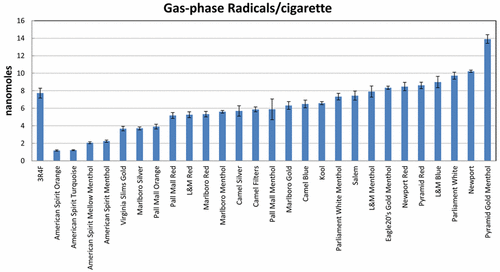Credit: American Chemical Society
Smoking cigarettes can lead to illness and death. Free radicals, which are atoms or groups of atoms with unpaired electrons, in inhaled smoke are thought to be partly responsible for making smokers sick. Now researchers report in ACS' journal Chemical Research in Toxicology a method for measuring free radicals in cigarette smoke that could help improve our understanding of the relationship between these substances and health.
Cigarette smoking is the leading preventable cause of death in the U.S., according to the Centers for Disease Control and Prevention. Understanding why is a challenge, given that cigarette smoke is a complex mixture of more than 7,000 compounds. Much of the blame has been placed on the 93 cigarette-related carcinogens and toxins on the U.S. Food and Drug Administration's list of hazardous and potentially hazardous chemicals. But previous studies have reported that risk assessments based on these compounds underestimate the actual number of illnesses caused by smoking. Accounting for free radicals, which are known to cause oxidative damage in the body, could help fill that gap. But they are not listed on the FDA's list and are difficult to study because they don't stick around for long. So John P. Richie Jr. and colleagues wanted to find a reliable way to measure free radicals in cigarette smoke.
The researchers developed a standardized protocol for measuring free radicals in smoke first by using a control cigarette and a technique called electron paramagnetic resonance spectrometry. They then applied the same protocol to 27 varieties of commercial cigarettes. The study found that the levels of gas-phase radicals ranged widely across the varieties while particulate-phase radicals showed less variability. An analysis of potential factors accounting for the differences found that highly ventilated cigarettes tended to produce lower levels of both gas- and particulate-phase free radicals. The researchers say their method could be used to assess people's exposure to free radicals, which can help determine potential health effects.
More information: Reema Goel et al. Variation in Free Radical Yields from U.S. Marketed Cigarettes, Chemical Research in Toxicology (2017). DOI: 10.1021/acs.chemrestox.6b00359
Abstract
Free radicals in tobacco smoke are thought to be an important cause of smoking-induced diseases, yet the variation in free radical exposure to smokers from different brands of commercially available cigarettes is unknown. We measured the levels of highly reactive gas-phase and stable particulate-phase radicals in mainstream cigarette smoke by electron paramagnetic resonance (EPR) spectroscopy with and without the spin-trapping agent phenyl-N-tert-butylnitrone (PBN), respectively, in 27 popular US cigarettes and the 3R4F research cigarette, machine-smoked according to the FTC protocol. We find a 12-fold variation in the levels of gas-phase radicals (1.2 to 14 nmol per cigarette) and a 2-fold variation in the amounts of particulate-phase radicals (44 to 96 pmol per cigarette) across the range of cigarette brands. Gas and particulate-phase radicals were highly correlated across brands (ρ = 0.62, p < 0.001). Both radicals were correlated with TPM (gas-phase: ρ = 0.38, p = 0.04; particulate-phase: ρ = 0.44, p = 0.02) and ventilation (gas- and tar-phase: ρ = −0.58, p = 0.001), with ventilation explaining nearly 30% of the variation in radical levels across brands. Overall, our findings of significant brand variation in free radical delivery under standardized machine-smoked conditions suggest that the use of certain brands of cigarettes may be associated with greater levels of oxidative stress in smokers.
Journal information: Chemical Research in Toxicology
Provided by American Chemical Society





















